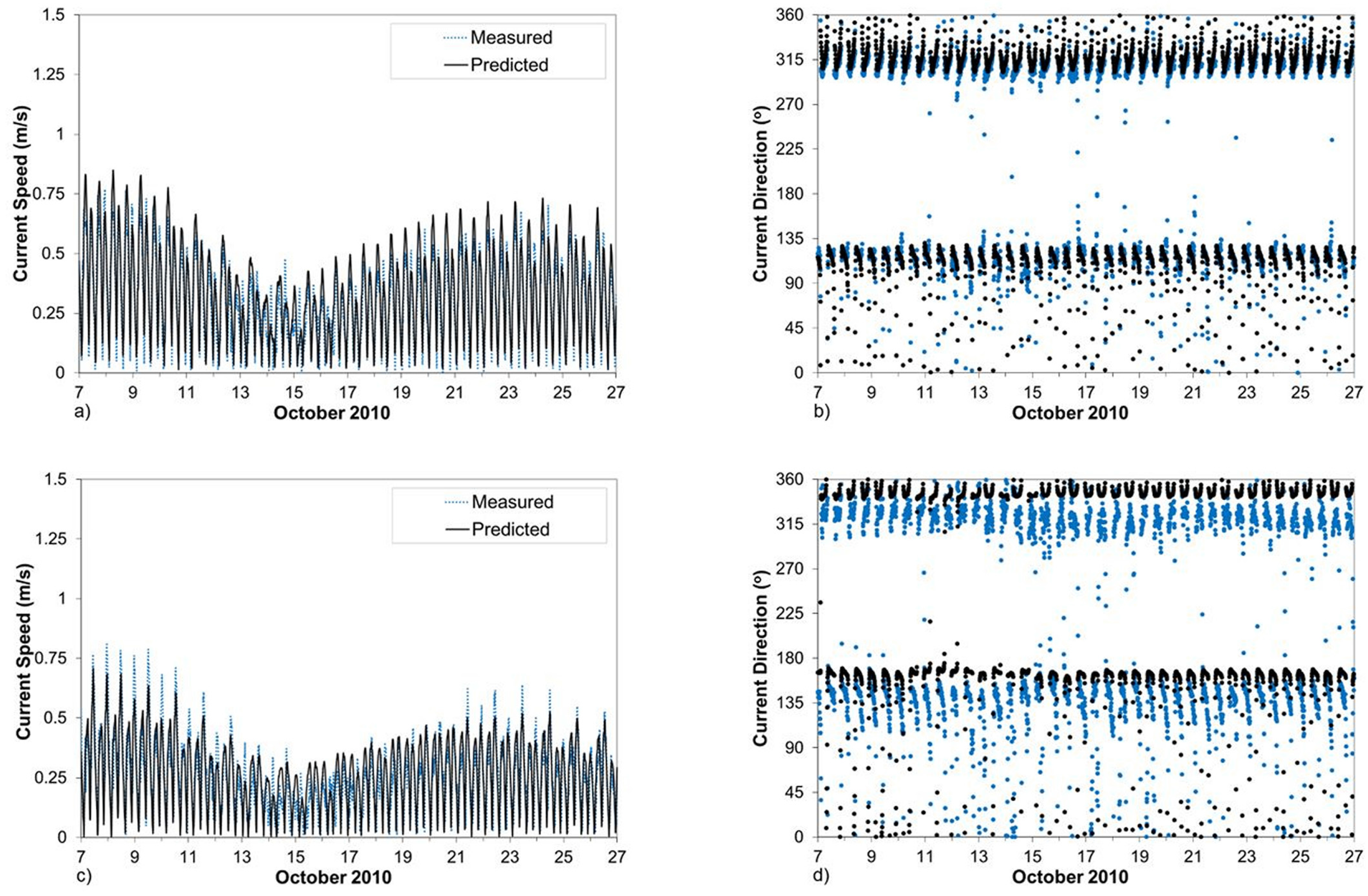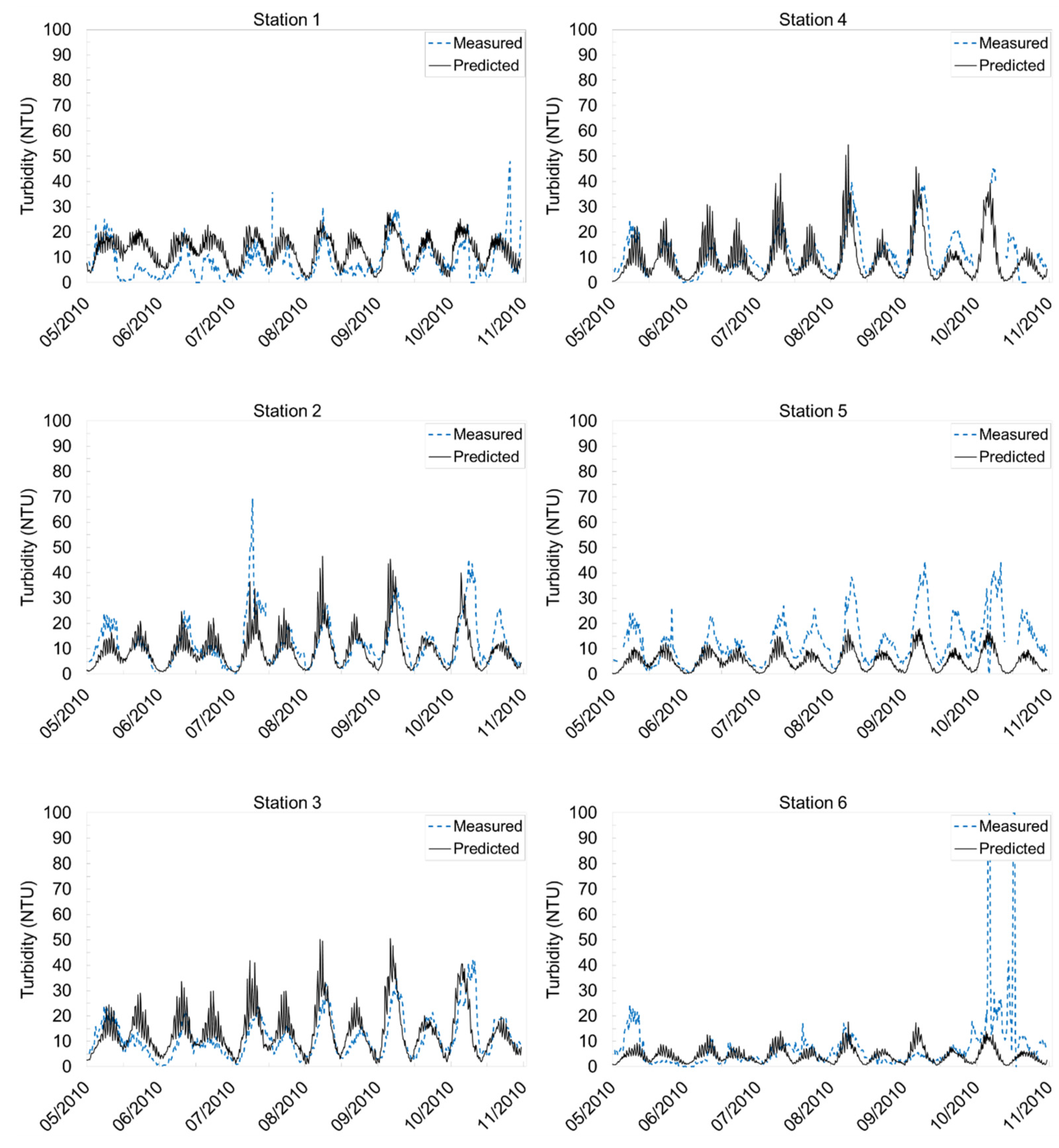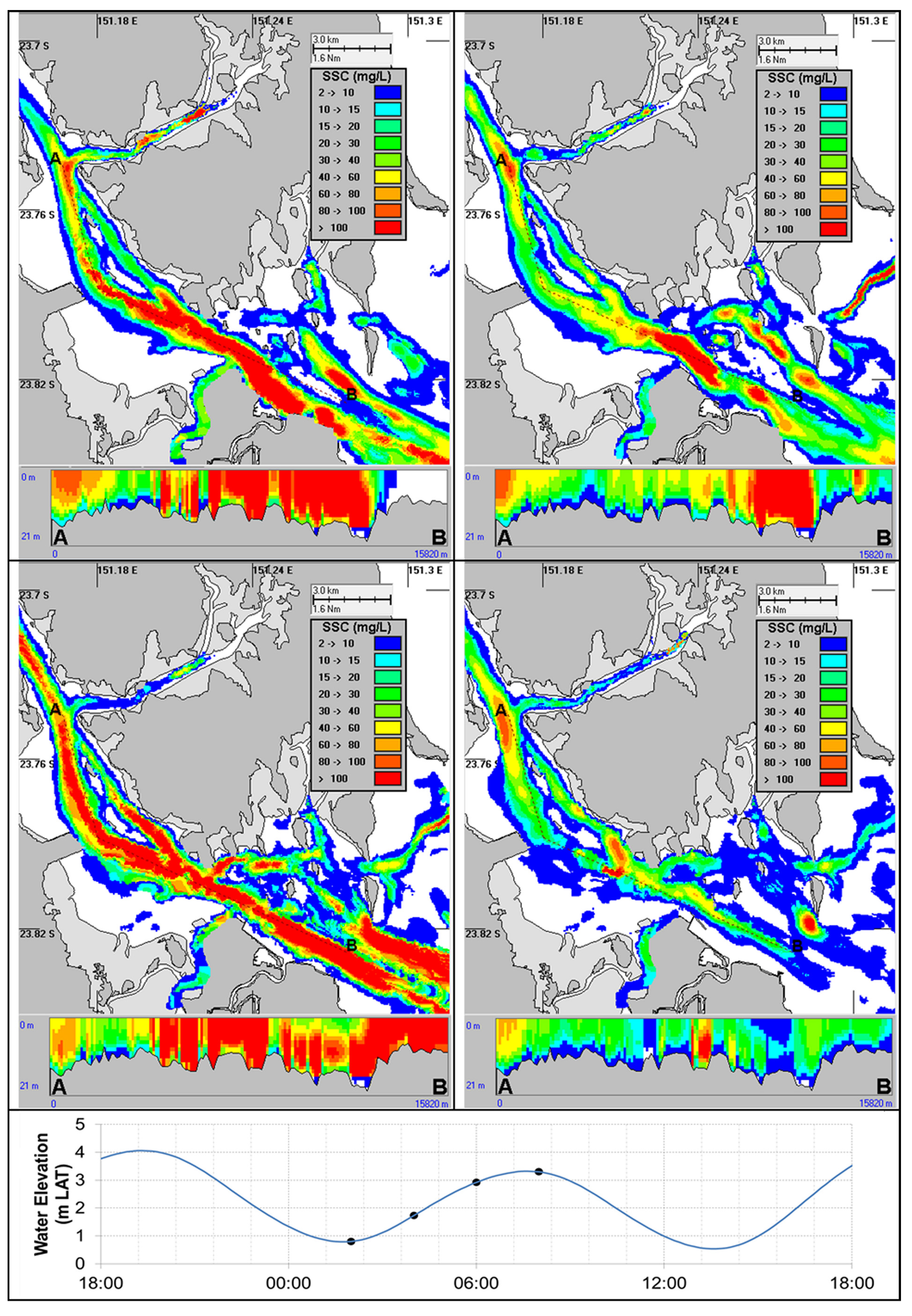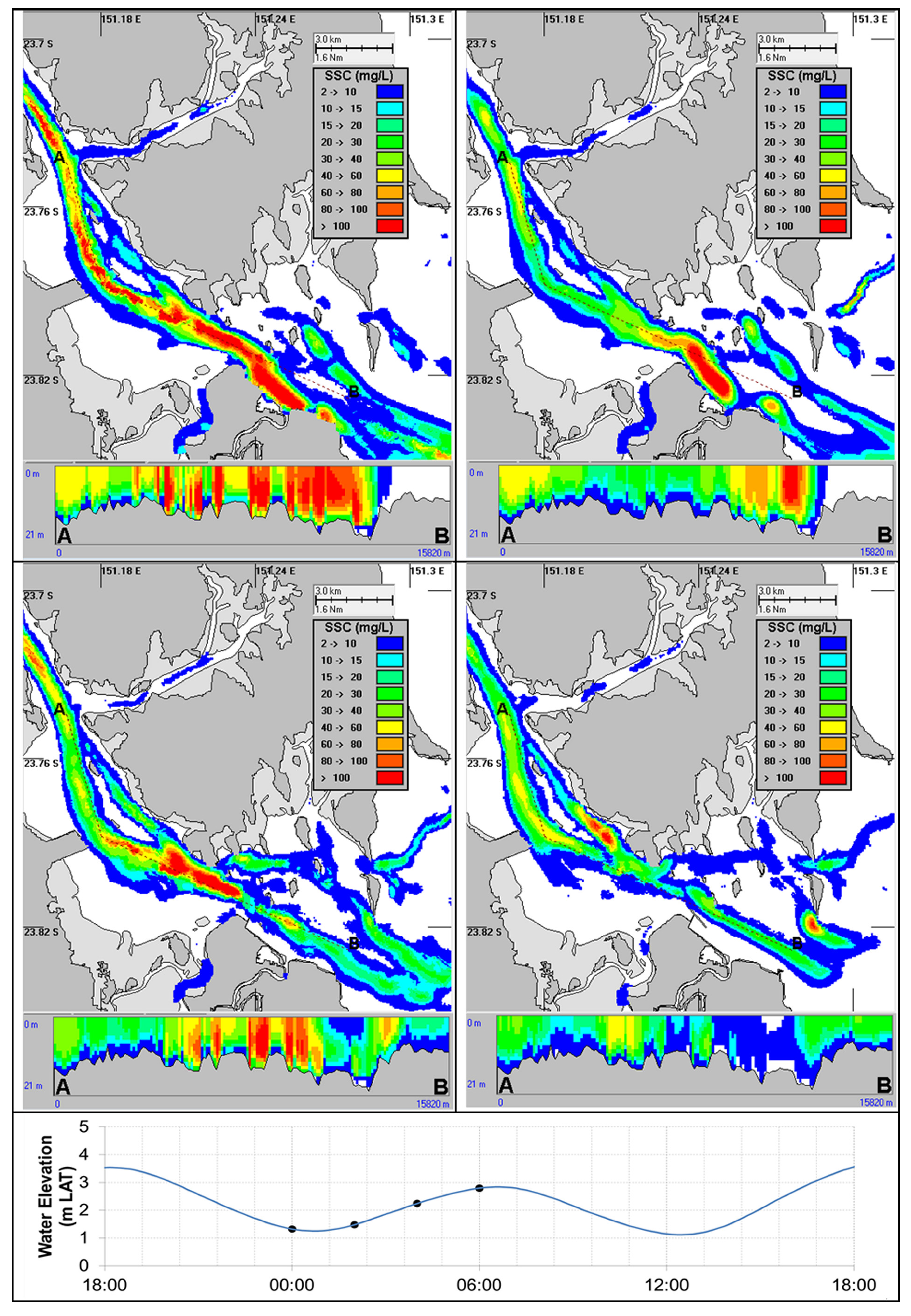Hydrodynamic and Sediment Modelling within a Macro Tidal Estuary: Port Curtis Estuary, Australia
Abstract
:1. Introduction
2. Study Site

3. Model Description
3.1. Hydrodynamic Model
3.2. Wave Model
3.3. Sediment Transport Model

4. Model Validation
4.1. Hydrodynamic Model

| Site | Depth Layer | Current Speed | ||
| R | IOA | MAE | ||
| Mid-estuary | Surface | 0.81 | 0.90 | 0.12 |
| Near-seabed | 0.92 | 0.92 | 0.07 | |
| Upper-estuary | Surface | 0.69 | 0.82 | 0.12 |
| Near-seabed | 0.78 | 0.88 | 0.08 | |
| Site | Depth Layer | Current Direction | ||
| R | IOA | MAE | ||
| Mid-estuary | Surface | 0.91 | 0.95 | 30.25 |
| Near-seabed | 0.96 | 0.97 | 16.43 | |
| Upper-estuary | Surface | 0.89 | 0.93 | 31.61 |
| Near-seabed | 0.91 | 0.94 | 35.42 | |
4.2. Wave Model
| Parameter | R | IOA | MAE |
|---|---|---|---|
| Significant wave height (Hs) | 0.82 | 0.59 | 0.80 |
| Peak wave period (Tp) | 0.54 | 0.72 | 1.40 |
| Peak wave direction (Pdir) | 0.93 | 0.94 | 18.49 |
4.3. Sediment Transport Model
| Station | Latitude (°S) | Longitude (°E) | Water Depth [HAT (m)] |
|---|---|---|---|
| 1 | 23.74802 | 151.16267 | 7 |
| 2 | 23.76538 | 151.18108 | 7 |
| 3 | 23.78768 | 151.19993 | 5 |
| 4 | 23.80845 | 151.21712 | 6 |
| 5 | 23.79588 | 151.23862 | 8 |
| 6 | 23.78308 | 151.30653 | 6 |


| Station | Hourly Datasets | ||
| R | IOA | MAE | |
| 1 | 0.07 | 0.22 | 7.07 |
| 2 | 0.51 | 0.68 | 8.97 |
| 3 | 0.66 | 0.57 | 12.57 |
| 4 | 0.47 | 0.58 | 12.28 |
| 5 | 0.50 | 0.50 | 10.02 |
| 6 | 0.13 | 0.25 | 7.17 |
| Station | Exponentially Weighted Moving Average (6 h) | ||
| R | IOA | MAE | |
| 1 | 0.49 | 0.64 | 6.19 |
| 2 | 0.63 | 0.75 | 5.19 |
| 3 | 0.71 | 0.83 | 4.98 |
| 4 | 0.75 | 0.80 | 5.33 |
| 5 | 0.74 | 0.58 | 8.14 |
| 6 | 0.17 | 0.30 | 4.96 |
5. Results and Model Applications
5.1. Hydrodynamic Conditions
5.2. Spatial and Temporal Turbidity Variations
| Estuary Region | Surface Current Speeds (m/s) | ||||||||
| Spring-Neap Tides | Spring Tides | Neap Tides | |||||||
| Mean | SD | Maximum | Mean | SD | Maximum | Mean | SD | Maximum | |
| Mid | 0.40 [0.40] | 0.26 [0.23] | 1.25 [1.00] | 0.45 [0.46] | 0.27 [0.24] | 1.25 [1.00] | 0.35 [0.35] | 0.23 [0.20] | 1.13 [0.84] |
| Upper | 0.32 [0.31] | 0.19 [0.17] | 1.02 [0.84] | 0.38 [0.33] | 0.21 [0.18] | 1.02 [0.84] | 0.26 [0.28] | 0.17 [0.15] | 0.83 [0.60] |
| Estuary Region | Near-Bottom Current Speed (m/s) | ||||||||
| Spring-Neap Tides | Spring Tides | Neap Tides | |||||||
| Mean | SD | Maximum | Mean | SD | Maximum | Mean | SD | Maximum | |
| Mid | 0.31 [0.33] | 0.17 [0.18] | 0.77 [0.85] | 0.35 [0.38] | 0.19 [0.20] | 0.77 [0.85] | 0.26 [0.30] | 0.14 [0.16] | 0.61 [0.72] |
| Upper | 0.26 [0.26] | 0.15 [0.14] | 0.81 [0.71] | 0.31 [0.29] | 0.15 [0.15] | 0.81 [0.71] | 0.21 [0.24] | 0.12 [0.12] | 0.62 [0.50] |
| Station | Percentile | Mean | SD | % RSD | ||
|---|---|---|---|---|---|---|
| 50th | 80th | 95th | ||||
| 1 | 7.28 [5.60] | 23.23 [13.30] | 37.38 [25.80] | 12.62 [8.51] | 11.66 [10.14] | 92.53 [119.25] |
| 2 | 6.68 [9.00] | 18.31 [19.10] | 26.96 [33.90] | 9.58 [12.62] | 11.63 [11.80] | 121.30 [93.67] |
| 3 | 8.68 [9.10] | 20.86 [17.40] | 42.50 [31.10] | 13.60 [11.58] | 12.80 [9.49] | 105.82 [81.90] |
| 4 | 4.83 [9.05] | 11.78 [17.40] | 35.14 [32.00] | 9.23 [11.77] | 14.13 [10.75] | 153.02 [91.39] |
| 5 | 1.92 [10.50] | 9.09 [20.10] | 21.07 [34.00] | 5.32 [13.35] | 7.26 [10.55] | 136.02 [81.42] |
| 6 | 1.92 [4.40] | 5.52 [9.80] | 17.99 [29.60] | 4.31 [7.48] | 6.74 [15.10] | 15.65 [20.92] |


6. Conclusions
Acknowledgments
Author Contributions
Conflicts of Interest
References
- Stumpf, R.P.; Haines, J.W. Variations in tidal level in the Gulf of Mexico and implications for tidal wetlands. Estuar. Coast. Shelf Sci. 1998, 46, 165–173. [Google Scholar] [CrossRef]
- Potter, I.C.; Tweedley, J.R.; Elliott, M.; Whitfield, A.K. The ways in which fish use estuaries: A refinement and expansion of the guild approach. Fish Fish. 2013, 16, 230–239. [Google Scholar] [CrossRef]
- Sheaves, M.; Baker, R.; Nagelkerken, I.; Connolly, R.M. True value of estuarine and coastal nurseries for fish: Incorporating complexity and dynamics. Estuar. Coasts 2014, 38, 401–414. [Google Scholar] [CrossRef]
- De la Paz, M.; Gómez-Parra, A.; Forja, J. Tidal-to-seasonal variability in the parameters of the carbonate system in a shallow tidal creek influenced by anthropogenic inputs, Rio San Pedro (SW Iberian Peninsula). Cont. Shelf Res. 2008, 28, 1394–1404. [Google Scholar] [CrossRef]
- Roy, P.S.; Williams, R.J.; Jones, A.R.; Yassini, I.; Gibbs, P.J.; Coates, B.; West, R.J.; Scanes, P.R.; Hudson, J.P.; Nichol, S. Structure and function of south-east Australian estuaries. Estuar. Coast. Shelf Sci. 2001, 53, 351–384. [Google Scholar] [CrossRef]
- Barbier, E.B.; Hacker, S.D.; Kennedy, C.; Koch, E.W.; Stier, A.C.; Silliman, B.R. The value of estuarine and coastal ecosystem services. Ecol. Monogr. 2011, 81, 169–193. [Google Scholar] [CrossRef]
- Zhang, K.; Liu, H.; Li, Y.; Xu, H.; Shen, J.; Rhome, J.; Smith, T.J., III. The role of mangroves in attenuating storm surges. Estuar. Coast. Shelf Sci. 2012, 102, 11–23. [Google Scholar] [CrossRef]
- Gedan, K.B.; Kirwan, M.L.; Wolanski, E.; Barbier, B.B.; Silliman, B.R. The present and future role of coastal wetland vegetation in protecting shorelines: Answering recent challenges to the paradigm. Clim. Chang. 2011, 106, 7–29. [Google Scholar] [CrossRef]
- Wang, X.H.; Pinardi, N. Modeling the dynamics of sediment transport and resuspension in the northern Adriatic Sea. J. Geophys. Res. 2002, 107. [Google Scholar] [CrossRef]
- Vandermeulen, J.H. Environmental trends in ports and harbours: Implications for planning and management. Maritime Policy Manag. 1996, 23, 55–66. [Google Scholar] [CrossRef]
- Machiwa, J.F. Anthropogenic pollution in the Dar es Salaam harbour area, Tanzania. Mar. Pollut. Bull. 1992, 24, 562–567. [Google Scholar] [CrossRef]
- Oviatt, C.A.; Nixon, S.W. Sediment resuspension and deposition in Narrangansett Bay. Estuar. Coast. Mar. Sci. 1975, 3, 201–217. [Google Scholar] [CrossRef]
- Black, K.S. Suspended sediment dynamics and bed erosion in the high shore mudflat region of the Humber Estuary, UK. Mar. Pollut. Bull. 1998, 37, 122–133. [Google Scholar] [CrossRef]
- Allan, J.R.L.; Duffy, M.J. Medium-term sedimentation on high intertidal mudflats and salt marshes in the Severn Estuary, SW Britain: The role of wind and tide. Mar. Geol. 1998, 150, 1–27. [Google Scholar] [CrossRef]
- Regnier, P.; Wollast, R. Distribution of trace metals in suspended matter of the Scheldt estuary. Mar. Chem. 1993, 43, 3–19. [Google Scholar] [CrossRef]
- Christiansen, C.; Gertz, F.; Laima, M.J.C.; Lund-Hansen, L.C.; Vang, T.; Jürgensen, C. Nutrient (P, N) dynamics in the southwestern Kattegat, Scandinavia: Sedimentation and resuspension effects. Environ. Geol. 1997, 29, 66–77. [Google Scholar] [CrossRef]
- Cloern, J.E.; Nichols, F.H. Time scales and mechanisms of estuarine variability, a synthesis from studies of San Francisco Bay. Hyrdobiologia 1985, 129, 229–237. [Google Scholar] [CrossRef]
- Morin, J.; Morse, J.W. Ammonium release from resuspended sediments in the Laguna Madre estuary. Mar. Chem. 1999, 65, 97–110. [Google Scholar] [CrossRef]
- Tengberg, A.; Almroth, E.; Hall, P. Resuspension and its effects on organic carbon recycling and nutrient exchange in coastal sediments: In situ measurements using new experimental technology. J. Exp. Mar. Biol. Ecol. 2003, 285, 119–142. [Google Scholar] [CrossRef]
- Anthony, K.R.N.; Ridd, P.V.; Orpin, A.R.; Larcombe, P.; Lough, J. Temporal variation of light availability in coastal benthic habitats: Effects of clouds, turbidity, and tides. Limnol. Oceanogr. 2004, 49, 2201–2211. [Google Scholar] [CrossRef]
- Devlin, M.J.; Barry, J.; Mills, D.K.; Gowen, R.J.; Foden, J.; Sivyer, D.; Tett, P. Relationships between suspended particulate material, light attenuation and Secchi depth in UK marine waters. Estuar. Coast. Shelf Sci. 2008, 79, 429–439. [Google Scholar] [CrossRef]
- Liu, W.-C.; Hsu, M.-H.; Kuo, A.Y. Modelling of hydrodynamics and cohesive sediment transport in Tanshui River estuarine system, Taiwan. Mar. Pollut. Bull. 2002, 44, 1076–1088. [Google Scholar] [CrossRef]
- Wilbur, D.H.; Clarke, D.G. Biological effects of suspended sediments: A review of suspended sediment impacts on fish and shellfish with relation to dredging activities in estuaries. North Am. J. Fish. Manag. 2001, 21, 855–875. [Google Scholar] [CrossRef]
- Wong, C.K.; Pak, I.A.P.; Liu, X.J. Gill damage to juvenile orange-spotted grouper Epinephelus coioides (Hamilton, 1822) following exposure to suspended sediments. Aquac. Res. 2013, 44, 1865–1695. [Google Scholar] [CrossRef]
- Norkko, J.; Hewitt, J.E.; Thrush, S.F. Effects of increased sedimentation on the physiology of two estuarine soft-sediment bivalves, Austrovenus stutchburyi and Paphies australis. J. Exp. Mar. Biol. Ecol. 2006, 333, 12–26. [Google Scholar] [CrossRef]
- Droppo, I.G.; Krishnappan, B.G.; Liss, S.N.; Marvin, C.; Biberhofer, J. Modelling sediment-microbial dynamics in the South Nation River, Ontario, Canada: Towards the prediction of aquatic and human health risk. Water Res. 2011, 45, 3797–3809. [Google Scholar] [CrossRef] [PubMed]
- Lopes, J.F.; Dias, J.M.; Dekeyser, I. Numerical modeling of cohesive sediments transport in the Ria de Aveirolagoon, Portugal. J. Hydrol. 2006, 319, 176–198. [Google Scholar] [CrossRef]
- Andutta, F.P.; Wang, X.H.; Li, L.; Williams, D. Hydrodynamics and sediment transport in a macro-tidal estuary: Darwin Harbour, Australia. In Estuaries of Australia in 2050 and Beyond; Wolanski, E., Ed.; Springer: Dordrecht, The Netherlands, 2014; pp. 111–129. [Google Scholar]
- Ali, A.; Lemckert, C.J.; Zhang, H.; Dunn, R.J.K. Sediment Dynamics of a Very Shallow Subtropical Estuarine Lake. J. Coast. Res. 2010, 26, 436–443. [Google Scholar] [CrossRef]
- Brand, A.; Lacy, J.R.; Hsu, K.; Hoover, D.; Gladding, S.; Stacey, M.T. Wind-enhanced resuspension in the shallow waters of South San Francisco Bay: Mechanisms and potential implications for cohesive sediment transport. J. Geophys. Res. 2010, 115, C11024. [Google Scholar] [CrossRef]
- Giardino, A.; Ibrahim, E.; Adam, S.; Toorman, E.A.; Monbaliu, J. Hydrodynamics and cohesive sediment transport in the Ijzer estuary, Belgium: Case study. J. Waterw. Port Coast. Ocean Eng. 2009, 135, 176–184. [Google Scholar] [CrossRef]
- Guan, W.B.; Wolanski, E.; Dong, L.X. Cohesive sediment transport in the Jiaojiang River estuary, China. Estuar. Coast. Shelf Sci. 1998, 46, 861–871. [Google Scholar] [CrossRef]
- Hayter, E.J.; Mehta, A.J. Modelling cohesive sediment transport in estuarial waters. Appl. Math. Model. 1986, 10, 294–303. [Google Scholar] [CrossRef]
- Carniello, L.; Defina, A.; D’Alpaos, L. Modeling sand-mud transport induced by tidal currents and wind waves in shallow microtidal basins: Application to the Venice Lagoon (Italy). Estuar. Coast. Shelf Sci. 2012, 102, 105–115. [Google Scholar] [CrossRef]
- Cancino, L.; Neves, R. Hydrodynamic and sediment suspension modelling in estuarine systems: Part II. Application to the Western Scheldt and Gironde estuaries. J. Mar. Syst. 1999, 22, 117–131. [Google Scholar] [CrossRef]
- Lumborg, U. Cohesive sediment transport modelling application to the Lister Dyb tidal area in the Danish Wadden Sea. J. Coast. Res. 2004, 41, 114–123. [Google Scholar]
- Le Normant, C. Three-dimensional modelling of cohesive sediment transport in the Loire estuary. Hydrol. Process. 2000, 14, 2231–2243. [Google Scholar] [CrossRef]
- Lumborg, U.; Pejrup, M. Modelling of cohesive sediment transport in a tidal lagoon—An annual budget. Mar. Geol. 2005, 218, 1–16. [Google Scholar] [CrossRef]
- Gladstone Ports Corporation Ltd. History of the Gladstone Ports Corporation limited. Available online: http://www.gpcl.com.au/AboutGPC/HistoryofGPC.aspx (accessed on 23 March 2015).
- Walker, M.H. Fisheries Resources of the Port Curtis and Capricorn Regions; Queensland Fisheries Management Authority: Brisbane, Australia, 1997.
- Connolly, R.M.; Currie, D.R.; Danaher, K.F.; Dunning, M.; Melzer, A.; Platten, J.R.; Shearer, D.; Stratford, P.J.; Teasdale, P.R.; Vadergradt, M. Intertidal Wetlands of Port Curtis: Ecological Patterns and Processes and Their Implications; Research Centre for Coastal Zone, Estuary and Waterway Management: Brisbane, Australia, 2006. [Google Scholar]
- Connolly, R.M.; Guest, M.A. Critical Estuarine Habitats for Food Webs Supporting Fisheries in Port Curtis, Central Queensland, Australia; Griffith University and the Cooperative Research Centre for Coastal Zone, Estuary and Waterway Management: Brisbane, Australia, 2004. [Google Scholar]
- Jones, M-A.; stauber, J.; Apte, S.; Simpson, S.; Vicente-Beckett, V.; Johnson, R.; Duivenvoorden, L. A risk assessment approach to contaminants in Port Curtis, Queensland, Australia. Mar. Pollut. Bull. 2005, 51, 448–458. [Google Scholar] [CrossRef] [PubMed]
- Anastasi, A.; Wilson, S.P. A review of manganese in subtropical estuaries: Port Curtis—A case study. Australas. J. Ecotoxicol. 2010, 16, 119–133. [Google Scholar]
- Andersen, L.; Norton, J. Port Curtis Mud Crab shell Disease: Nature, Distribution and Management; Central Queensland University: Gladstone, Australia, 2001. [Google Scholar]
- Angel, B.; Hales, L.T.; Simpson, S.L.; Apte, S.S.; Chariton, A.A.; Shearer, D.; Jolley, D.F. Spatial variability of cadmium, copper, manganese, nickel and zinc in the Port Curtis Estuary, Queensland, Australia. Mar. Freshw. Res. 2010, 61, 170–183. [Google Scholar] [CrossRef]
- Herzfeld, M.; Parslow, J.; Andrewartha, J.; Sakov, P.; Webster, I.T. Hydrodynamic Modelling of the Port Curtis Region; Research Centre for Coastal Zone, Estuary and Waterway Management: Brisbane, Australia, 2004. [Google Scholar]
- Johnson, B.H.; Andersen, E.; Isaji, T.; Teeter, A.M.; Clarke, D.G. Description of the SSFATE Numerical Modeling System; U.S. Army Engineer Research and Development Centre: Vicksburg, MS, USA, 2000. [Google Scholar]
- Deltares. In Delft3D-FLOW User Manual, Version 3.15.34158; Deltares: Rotterdamseweg, The Netherlands, 2014; pp. 1–684.
- Pan, L.; Ding, P.; Ge, J. Impacts of deep waterway project on morphological changes within the north passage of the Changjiang estuary, China. J. Coast. Res. 2012, 28, 1165–1176. [Google Scholar] [CrossRef]
- Chen, Q.; Mynett, A.E. Modelling algal blooms in the Dutch coastal waters by integrated numerical and fuzzy cellular automata approaches. Ecol. Model. 2006, 199, 73–81. [Google Scholar] [CrossRef]
- Asia-Pacific ASA Pty Ltd. Asia-Pacific ASA Pty Ltd, Gold Coast, Australia. Unpublished work. 2010.
- Wolanski, E.; Jones, M.; Bunt, J.S. Hydrodynamics of a tidal creek-mangrove swamp system. Aust. J. Mar. Freshwater Res. 1980, 31, 431–450. [Google Scholar] [CrossRef]
- King, B.; Wolanski, E. Bottom friction reduction in turbid estuaries. In Coastal and Estuarine Studies; Prandle, D., Ed.; American Geophysical Union: Washington, DC, 1996; Volume 50, pp. 325–337. [Google Scholar]
- Booij, N.; Ris, R.C.; Holthuijsen, L.H. A third-generation wave model for coastal regions: 1. Model description and validation. J. Geophys. Res. Oceans 1999, 104, 7649–7666. [Google Scholar] [CrossRef]
- Tolman, H.L. User Manual and System Documentation of WAVEWATCH-III, Version 2.22; U.S. Department of Commerce, NOAA, Environmental Modelling Centre Marine Modelling and Analysis Branch: Washington, DC, USA, 2002; pp. 1–133.
- Eldeberky, Y.; Battjes, J.A. Spectral modelling of wave breaking: Application to Boussinesq equations. J. Geophys. Res. 1996, 101, 1253–1264. [Google Scholar] [CrossRef]
- Collins, J.I. Prediction of shallow water spectra. J. Geophys. Res. 1972, 77, 2693–2707. [Google Scholar] [CrossRef]
- Howlett, E. GIS-based tools in support of Dredging Operations. Sea Technol. 2003, 44, 42–44. [Google Scholar]
- Spearman, J.; Bray, R.N.; Burt, J.L.; Burt, T.N.; Mead, C.T.; Scott, D. Plume dispersion modelling using dynamic representation of trailer dredger source terms. Proc. Mar. Sci. 2007, 8, 417–448. [Google Scholar]
- Swanson, J.C.; Isaji, T.; Galagan, C. Modeling the Ultimate Transport and Fate of Dredge-Induced Suspended Sediment Transport and Deposition. In Proceedings of the WODCON XVIII 27, Lake Buena Vista, FL, USA, 27 May–1 June 2007.
- Soulsby, R.L. Dynamics of Marine Sands: A Manual for Practical Application; Thomas Telford: London, UK, 1997; pp. 1–249. [Google Scholar]
- Sanford, L.P.; Maa, J.P.-Y. A unified erosion formulation for fine sediments. Mar. Geol. 2001, 179, 9–23. [Google Scholar] [CrossRef]
- Lin, J.; Wang, H.V.; Oh, J.-H.; Park, K.; Kim, S.-C.; Shen, J.; Kuo, A.Y. A new approach to model sediment resuspension in tidal estuaries. J. Coast. Res. 2003, 19, 76–88. [Google Scholar]
- Van Rijn, L.C. Handbook Sediment Transport by Currents and Waves, 2nd ed.; Delft Hydraulic. Lab: Delft, The Netherlands, 1989; pp. 1–307. [Google Scholar]
- GeoCoastal Australia Pty Ltd. GeoCoastal Australia Pty Ltd, Brisbane, Australia. Unpublished work. 2010.
- Bartier, P.M.; Keller, P.C. Multivariate interpolation to incorporate thematic surface data using inverse distance weighting (IDW). Comput. Geosci. 1996, 22, 795–799. [Google Scholar] [CrossRef]
- Ward, L.G.; Kemp, W.M.; Boynton, W.R. The influence of waves and seagrass communities on suspended particulates in an estuarine embayment. Maine Geol. 1984, 59, 85–103. [Google Scholar] [CrossRef]
- Wood, R.; Widdows, J. A model of sediment transport over an intertidal transect, comparing the influences of biological and physical factors. Limnol. Oceanogr. 2002, 47, 848–855. [Google Scholar] [CrossRef]
- Nowell, A.R.M.; Jumars, P.A.; Eckman, J.E. Effects of biological activity on the entrainment of marine sediments. Marine Geol. 1981, 42, 133–153. [Google Scholar] [CrossRef]
- Environmetrics Australia Pty Ltd. Environmetrics Australia Pty Ltd, Beaumaris, Australia. Unpublished work. 2010.
- Willmott, C.J. On the Validation of Models. Phys. Geogr. 1981, 2, 184–194. [Google Scholar]
- Willmott, C.J.; Matsuura, K. Advantages of the mean absolute error (MAE) over the root mean square error (RMSE) in assessing average model performance. Clim. Res. 2005, 30, 79–82. [Google Scholar] [CrossRef]
- Gladstone Wave Monitoring. Available online: http://www.qld.gov.au/environment/coasts-waterways/beach/waves-sites/gladstone/ (accessed on 3 March 2015).
- Climate Statistics for Australian Locations: Summary statistics Gladstone airport. Available online: http://www.bom.gov.au/climate/averages/tables/cw_039326.shtml (accessed on 5 March 2015).
- GHD Pty Ltd. Western Basin Dredging and Disposal Project Chapter 6—Hydrodynamic Modelling; GHD Pty Ltd/Gladstone Ports Corporation: Brisbane, Australia, 2010. [Google Scholar]
- Vision Environment (QLD) Pty Ltd. Western Basin Dredging and Disposal Project Water quality Monitoring; Vision Environment: Gladstone, Australia, 2012; pp. 1–89. [Google Scholar]
- Department of Environment and Heritage Protection. Queensland Water Quality Guidelines, Version 3; Department of Environment and Heritage Protection: Brisbane, Australia, 2009; pp. 1–184.
- Australia and New Zealand Environment and Conservation Council (ANZECC)/Agriculture and Resource Management Council of Australia and New Zealand (ARMCANZ). Australian and New Zealand Guidelines for Fresh and Marine Water Quality Volume 2—Rationale and Background Information; ANZECC/ARMCANZ: Canberra, Australia, 2000.
© 2015 by the authors; licensee MDPI, Basel, Switzerland. This article is an open access article distributed under the terms and conditions of the Creative Commons Attribution license ( http://creativecommons.org/licenses/by/4.0/).
Share and Cite
Dunn, R.J.K.; Zigic, S.; Burling, M.; Lin, H.-H. Hydrodynamic and Sediment Modelling within a Macro Tidal Estuary: Port Curtis Estuary, Australia. J. Mar. Sci. Eng. 2015, 3, 720-744. https://doi.org/10.3390/jmse3030720
Dunn RJK, Zigic S, Burling M, Lin H-H. Hydrodynamic and Sediment Modelling within a Macro Tidal Estuary: Port Curtis Estuary, Australia. Journal of Marine Science and Engineering. 2015; 3(3):720-744. https://doi.org/10.3390/jmse3030720
Chicago/Turabian StyleDunn, Ryan J. K., Sasha Zigic, Murray Burling, and Hsin-Hui Lin. 2015. "Hydrodynamic and Sediment Modelling within a Macro Tidal Estuary: Port Curtis Estuary, Australia" Journal of Marine Science and Engineering 3, no. 3: 720-744. https://doi.org/10.3390/jmse3030720
APA StyleDunn, R. J. K., Zigic, S., Burling, M., & Lin, H.-H. (2015). Hydrodynamic and Sediment Modelling within a Macro Tidal Estuary: Port Curtis Estuary, Australia. Journal of Marine Science and Engineering, 3(3), 720-744. https://doi.org/10.3390/jmse3030720





